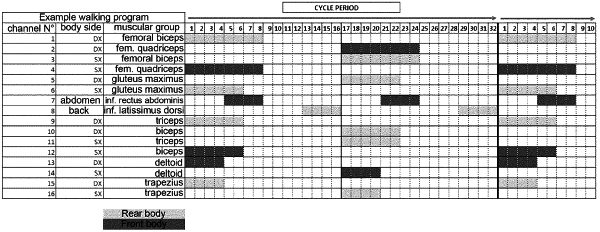| CPC A61N 1/0452 (2013.01) [A61N 1/0456 (2013.01); A61N 1/36003 (2013.01); A61N 1/36034 (2017.08)] | 16 Claims |

|
1. An electrostimulation method of at least one muscle group responsible for performing a complex cyclic movement, the method comprising the steps of:
creating an electrostimulation program based on an electromyographic recording of the complex cyclic movement, wherein the electrostimulation program is adapted to provide synchronized electrostimulation of the muscles of the at least one muscle group to allow reproduction of the complex cyclic movement;
associating to each of the muscles of the at least one muscle group an electrostimulation channel provided with at least one respective electrode, each electrostimulation channel being adapted to transmit to a respective muscle bipolar electrical pulses in sequence;
determining, for all the electrostimulation channels, a same cycle time defining a repeatable period of stimulation, wherein within said stimulation period each channel performs an associated stimulation sequence according to the electrostimulation program;
sub-dividing each stimulation period into two half-periods of equal duration;
sub-dividing each half-period into a plurality of sub-intervals of a same duration,
wherein at least one of said sub-intervals is a stimulation sub-interval in which a basic sequence of pulses comprising one or more pulse packets is performed, each pulse packet being given by a predetermined sequence of individual bipolar electric pulses, and
wherein each stimulation period of each channel has a half-period free of basic pulse sequences and has an other half-period with at least one stimulation sub-interval, and at least two stimulation periods of respective channels have different half-periods lacking basic pulse sequences.
|